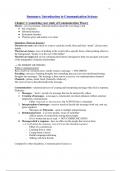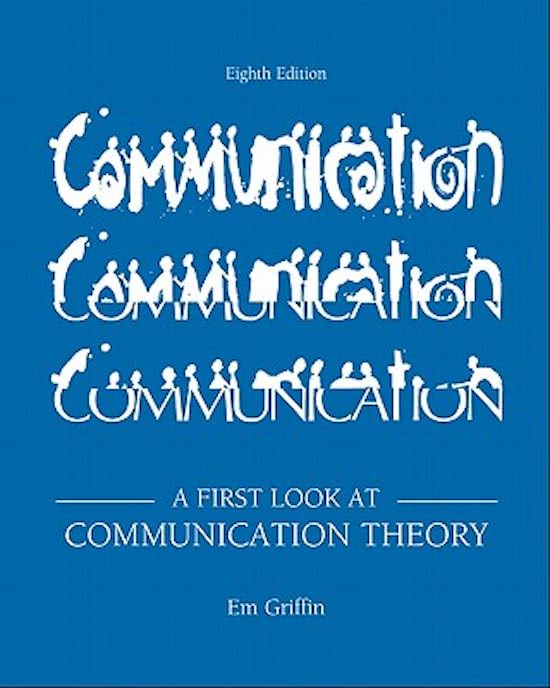1
Summary: Introduction to Communication Science
Chapter 1: Launching your study of Communication Theory
Theory - set of systematic, informal hunches about the way things work
● Set of hunches
● Informed hunches
● Systematic hunches
● Theories grow and mature over time!
Metaphors: What are theories?
Theories are nets with which we want to catch the world, finer and finer “mesh”, always more
details.
Theories are lenses, ways of looking at the world with a specific focus, while pushing others to
the background, “beauty is in the eye of the holder”.
Theories are maps that are [in communication theory] designed to help you navigate some part
of the topography of human relationships.
→ NO WRIGHT OR WRONG
What is communication?
Basic model of communication: sender creates a message → ENCODING
Encoding - process of turning thoughts into something that can exit your mind/transforming
thoughts into messages. The message is then sent to a receiver via communication channels
Channels - phone, email, book, [basically whatever]…
The receiver has to decode/interpret the message.
Communication - relational process of creating and interpreting messages that elicit a response.
Elements:
1. Messages - “texts”, record of a message that can be analysed by others.
2. Creation of messages - a message is constructed, invented, planned, crafted, selected,
adopted by communicator.
- Either conscious or unconscious, but ALWAYS have a meaning!
3. Interpretation of messages - receiver needs to decode the message (work out, sort out,
piece together).
- Messages are Polysemic - open to multiple interpretations.
4. Relational process - 2 or more people, aware of eachother
- Affects nature of connections among those people
- If it is written but never read → NOT COMMUNICATION
5. Messages elicit a response - have an effect on the people that receive them
→ it is all about the response, even if it’s not the intended response!
- Effect of a commercial
- Learning from a video
- Crying about a movie
- Health campaign informing
- Talking with best friends
Compared to other disciplines, Communication Science is:
, 2
● Object-oriented
● Inter-disciplinary
Chapter 2: Objective and Interpretive Approaches to Comm Theory
Example: Budweiser (beer) commercial - horse taken away by Budweiser truck…
● Objective approach: Glenn Sparks (behavioral scientist)
→ truth is singular and is accessible through unbiased sensory observation; cause and effect
relationships
● Interpretive approach: Matty Medhurst (linguist)
→ assigning meaning to texts; assumption that multiple truths are possible
OBJ - Resonance principle of comm
- Message evokes past experiences, resonance between message and person’s thoughts or
feelings
- It is not arguments but memories that are effective for persuasion
Elements in commercial → positive attitude towards product → likelihood of purchasing it
Can be tested: Does the commercial lead to positive attitude?
Does this positive attitude lead to increased likelihood of buying the product?
INT - (Collective unconscious) “Birth-death-rebirth”
- Birth of young horse [BIRTH]
- Taken care of by breader
- Maturing to grown horse
- Taken away by Budweiser truck [DEATH]
- Reunited with breader after years [REBIRTH]
→ interpreting what we see in the “text”
OBJ vs INT
- Important to know underlying assumptions
- The different views reflect on how we get knowledge, purpose and methods of research
Dimensions:
1. Ways of knowing: Discovering truth or creating multiple realities
OBJ - one truth! Not much room for interpretation
Ex: The Earth is round. (no room for speculation)
INT - subjective and socially constructed truths
- Deal with different questions
- Social phenomena are difficult to understand with OBJ
- Your own values influence how you perceive others
Ex: Eating meat is bad - depends on who you ask (farmer or vegan…)
2. Human nature: Determinism VS Free will?
OBJ - Determinism: human behavior as a consequence of heredity and environment
(nature and/or nurture debate)
, 3
INT - Free will: conscious choices made by people
“I am the master of my fate, captain of my soul.” - human behavior is voluntary
Can people be held responsible for their actions?
→ Scientists do not like either extremes!
3. Highest value: (why is research important?) OBJECTIVITY or EMANCIPATION?
OBJ - Finding the truth
- Objective hypothesis testing
- Empirical evidence
- Exclude own values
- It is about what “is”
INT - Understanding
- Including own values of what is right and wrong
- Research is there to “make the world a better place”
- About liberating and empowering people
- It is about “what ought to be”
4. Purpose of theory: Universal laws or Interpretive Guidelines
OBJ - Seeking for universal laws
- Never complete proof
INT - interpreting and giving meaning to particular “texts”
- Not about “proving”, more about “understanding”
Chapter 3: Weighing the words
What makes a theory good?
OBJECTIVE THEORY
Standard 1: Prediction of future events
- If A occurs, B should follow - predicts what will happen
- Figuring out a pattern, universal law
- Dealing with things we can touch, see, hear, smell, taste, over and over again
- In social sciences, we look at the likeability of something happening
- Never absolutely sure it will happen
Ex: Social Learning Theory - Bandura
→ (Aggressive) behavior doesn’t come from internal forces, but can be influenced by copying
behavior of others
- Bobo-doll experiments: torturing/harming dolls, kids copying adult violent behavior
Standard 2: Explanation of the data
- Objective theory “draws order out of chaos”
- Hypothesis - “informed hunch”
- We test this by gathering “data” for all the participants
- Goal: seeking patterns or relations - math and statistics
- Seeing if the patterns fit our hunches
, 4
Standard 3: Relative simplicity
- Objective theory should be as simple as possible
- Rule of parsimony (extreme unwillingness to spend resources): Given two plausible
explanations for the same event, we should first accept and test the simpler one.
Standard 4: Hypotheses that can be tested
- Objective theory should be testable
- Falsifiability: requirement that scientific theory must be stated in a way that can be tested
and disproved if it is wrong
- Some theories are so loosely stated that it is impossible to imagine empirical results that
could disprove their hypotheses
- A good theory is as precise as possible, but still parsimonious enough (relatively simple)
Ex: All swans are white. Good hypothesis?
→ YES, can be tested and disproved when you find a black (not white) swan.
→ falsifiable variable
Karl Popper: “looking at all swans in the world is impossible!”
Standard 5: Practical utility
- A good objective theory should be useful
- Kurt Lewin: “A good theory should be useful”
- How do I know it is a good one?
- See if others have used it (search, read…)
- Are there adaptations (improvements) on the theory, and if so why?
Standard 6: Quantitative research
- Collection of empirical data
- Comparison of differences or testing relations
- Experiment: manipulating IV in a controlled situation to find out if there is
changes that were predicted (hypothesis) in the DV
- Survey: questionnaire or structured interview to collect self-reported dta that
reflects respondents’ feelings/thoughts/intent…
INTERPRETIVE THEORY
Standard 1: Clarification of values
- Interpretive theories bring peoples’ values into the open
- Theorists actively seek to acknowledge, identify or unmask the ideology behind the
message
Standard 2: New understanding of people
- Fresh insight into human cognition
- Typically examines a one-of-a-kind speech community that exhibits specific (language)
tyles, or is a sub-culture
- In a good interpretive research, researchers include their own values and it is believed
impossible not to do so → SELF REFERENTIAL IMPERATIVE





